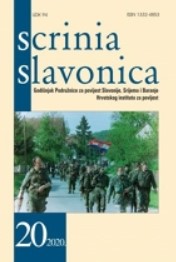Katoličko stanovništvo sela toliške kapelanije za vrijeme „Dubičkog rata“ (1788.-1791.)
The Catholic Population of the Villages of the Chaplaincy of Tolisa during the Time of the Dubica War (1788-1791)
Author(s): Marko MatolićSubject(s): Christian Theology and Religion, Military history, Social history, 18th Century, The Ottoman Empire, Migration Studies
Published by: Hrvatski institut za povijest
Keywords: Dubica War; Bosnian Posavina; relocation; Tolisa; Fratrovac; population;
Summary/Abstract: The last war in history fought between Austria and the Ottoman Empire is known as the “Dubica War” (1788-1791), and although the military actions were limited to a narrow area, this war had strong consequences for the population of the Catholic chaplaincyof Tolisa. The Turkish authorities, anxious to secure the cooperation of Catholics living on the banks of the Sava River, decided to systematically relocate those who had established their houses south of the river. War was officially declared on February 9, 1788 and in the following month around 1,600 inhabitants, as many as lived in the chaplaincy at the time, were relocated to the villages of the Dubrava parish and the chaplaincy of Tramošnica, particularly in the area between Blaževac and Porebrica where the new village Fratrovac was established, named after a friar who had settled there with his people. The newcomers to the area were accepted in a friendly manner by the local population and adapted well to the new environment. Until the return to their villages in August 1791, 223 children were born and 110 people died in exile. After their return to Posavina, some of the villages, such as Tolisa, Boka and Vidovica were not established at the former locations; the returnees chose new locations which became the centres from which the above villages as we know them today emerged.
Journal: Scrinia Slavonica
- Issue Year: 2020
- Issue No: 20
- Page Range: 79-92
- Page Count: 14
- Language: Croatian

